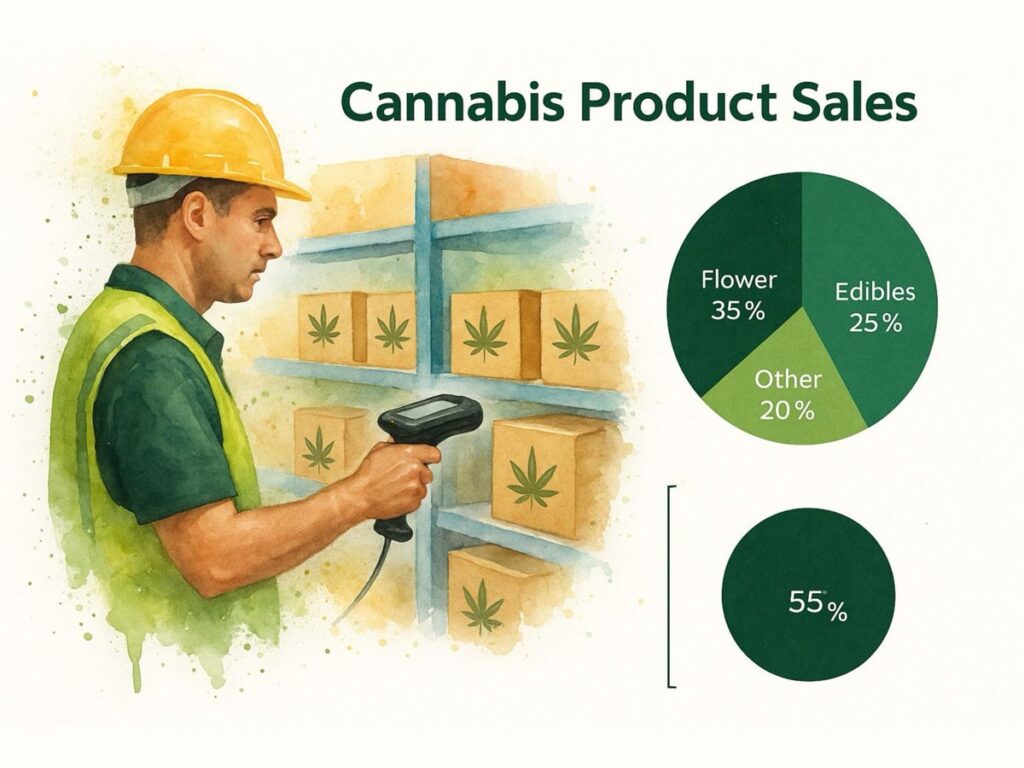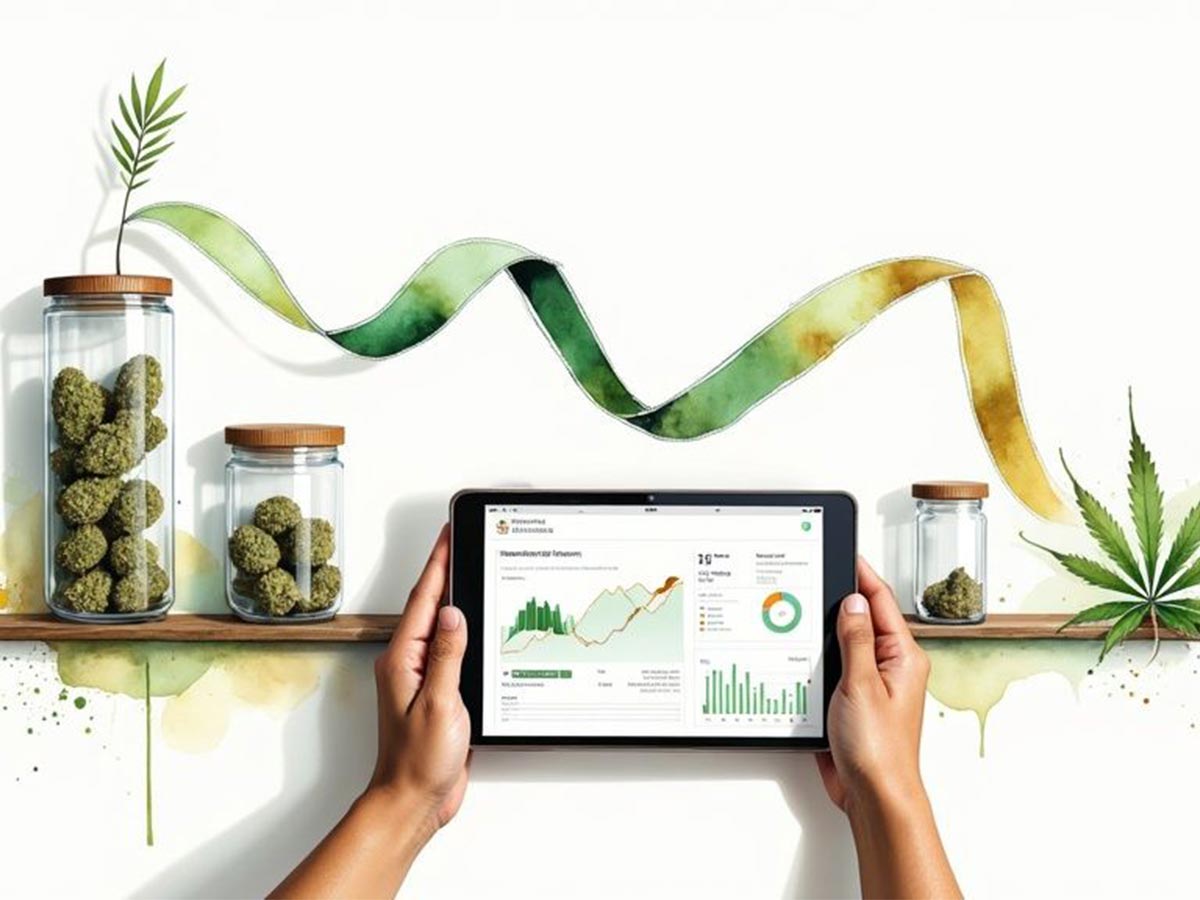Think of cannabis inventory management software as the central nervous system for your dispensary. It’s a specialized system built to track every single cannabis product from the moment it enters your store to the final sale, ensuring your business stays compliant with strict state laws and operates at peak efficiency.
This isn’t just about counting boxes. It’s a powerful compliance tool that automates the complex tracking and reporting that generic retail software simply cannot handle. Investing in the right system isn’t an expense; it’s a strategic move to protect your license and boost your bottom line.
Why Specialized Inventory Software is Non-Negotiable for Dispensaries
Running a dispensary is worlds away from managing a typical retail shop. You’re dealing with a tightly controlled product where every gram must be accounted for. It’s a high-stakes environment where following the rules isn’t just good practice—it’s essential for survival.
Attempting to run a dispensary with standard retail software is like trying to manage a pharmacy with a basic cash register. You’d have no way to track prescriptions, expiration dates, or adhere to federal regulations. It’s a gamble that leaves you wide open to devastating legal and financial consequences.
The Inevitable Failure of Standard Retail Systems
Generic inventory systems are perfectly fine for t-shirts or coffee mugs. They track stock levels and sales. Simple. But for the cannabis industry, they’re a compliance disaster waiting to happen.
These basic systems lack the crucial features needed to operate legally and efficiently:
- Seed-to-Sale Tracking: They cannot communicate with state-mandated systems like Metrc or BioTrack, which demand a complete, auditable history for every product.
- Potency and Batch Tracking: They have no fields for specific THC/CBD content, harvest dates, or the unique batch numbers tied to each item. For example, a standard system sees “one vape cartridge,” while a cannabis system sees “Batch #AB123, 88.7% THC, packaged on 10/15/24.”
- Purchase Limit Enforcement: They can’t stop a budtender from accidentally selling a customer more than their daily legal limit, a common and costly compliance violation.
- Complex Taxation: They aren’t built to handle the unique and often multi-layered tax rules specific to cannabis sales.
When you use a generic system, your team is forced to rely on a patchwork of spreadsheets and manual logs to fill the gaps. This isn’t just slow and frustrating; it’s a perfect recipe for human error. A single misplaced decimal or forgotten entry can easily trigger a state audit and eye-watering penalties. The risks are massive, with fines often reaching tens of thousands of dollars for a single violation. Just browse the enforcement actions published by agencies like the California Department of Cannabis Control—they don’t take this lightly.
The real challenge isn’t just managing what’s on the shelf; it’s managing compliance. One bad report can be the difference between a profitable month and a fine that shuts you down for good.
This is precisely why cannabis inventory management software was created. It’s engineered to navigate this regulatory minefield. It automates compliance, tracks products with forensic detail, and integrates seamlessly with your point-of-sale system. This creates a single, reliable source of truth, eliminates costly errors, and gives you a crystal-clear view of your business’s health. Choosing the right software isn’t about efficiency—it’s a foundational investment in protecting your business.
How Cannabis Inventory Software Actually Works
So, what’s happening under the hood of a cannabis inventory system? It’s much more than a digital stock list. Think of it as a high-security digital ledger for your entire operation, one that records every single touchpoint for every product. It’s your undeniable, audit-proof source of truth.
This process creates a complete, unbroken “chain of custody” for every item, from the moment it’s received to the second it walks out the door with a customer. This isn’t just a nice-to-have feature—it’s what regulators demand, and it’s something generic retail software can’t even begin to handle.
Every scan, every transfer, every sale is meticulously logged. It’s all about creating that perfect, real-time record.

As you can see, scanning technology is the backbone of the entire system, ensuring the digital record perfectly matches the physical inventory on your shelves and eliminating manual entry errors.
From Seed-to-Sale Automation
At its core, this software is built to automate the complicated dance of state compliance. Many states use a track-and-trace system like Metrc, which requires dispensaries to report nearly every action. Trying to do this by hand is not just tedious; it’s a direct risk to your license.
Cannabis-specific software is designed to communicate directly with these state systems. It hooks into their API (Application Programming Interface), creating a seamless, automated conversation between your store and the regulators.
- Practical Example: A new shipment of 50 vape cartridges arrives. Your staff scans the case’s manifest tag. The software instantly populates all 50 items into your inventory, complete with batch numbers and potency, and automatically reports the transfer to the state system. No manual data entry, no chance of a typo.
- A budtender makes a sale? The item’s unique ID is scanned, instantly deducting it from your inventory and reporting the sale to the state in real time. Your records always match theirs.
- Time for an audit? Instead of a stressful fire drill, it’s a simple cross-check. Your data is already synced and validated with the state’s records.
This integration transforms a high-stakes manual chore into a reliable background process, letting your team focus on serving customers, not wrestling with compliance data. You can learn more about how mobile tools simplify this by exploring the benefits of a dispensary app.
Managing Product-Specific Data
Selling cannabis isn’t like selling t-shirts. Every product comes with a wealth of unique data points that you are legally required to track. This is another area where generic software falls completely flat.
A standard retail system knows you sold one “shirt.” A cannabis system knows you sold 3.5 grams of Blue Dream from batch #A4C8, harvested on October 15th, with a THC content of 22.7% and CBD of 0.8%.
This level of detail is non-negotiable. The software must track cannabinoid profiles, harvest dates, lab test results, and unique package IDs. If a product is ever recalled, you can instantly identify and locate every single affected unit in seconds—a critical public safety function.
To put it in perspective, let’s compare standard retail software with a system built specifically for cannabis.
Comparing Standard vs. Cannabis Inventory Software
The table below breaks down exactly why a specialized solution is so essential. It’s not just about features; it’s about survival in a heavily regulated market.
| Feature | Standard Retail Software | Cannabis Inventory Management Software |
|---|---|---|
| Compliance Reporting | None. Not built for state-mandated tracking. | Automated reporting to state systems like Metrc, BioTrack, or Leaf Data Systems. |
| Product Tracking | Tracks basic SKUs and quantities. | Seed-to-sale tracking with batch numbers, lab results, and harvest dates. |
| Purchase Limits | Cannot enforce legal purchase limits. | Automatically calculates and enforces daily purchasing limits for medical and recreational customers. |
| Data Requirements | Manages price, quantity, and product name. | Tracks cannabinoid profiles (THC/CBD), terpene data, and expiration dates. |
| Age Verification | Basic or no integrated age verification tools. | Built-in ID scanning and age verification to prevent underage sales. |
| Chain of Custody | No concept of a legally required chain of custody. | Creates an auditable, unbroken record of every product’s journey. |
The difference is clear. One is for selling goods; the other is for running a compliant, defensible cannabis business. The cannabis retail Point of Sale (POS) software market is projected to skyrocket, showing just how vital these specialized systems have become.
Ultimately, this software is your compliance engine. It works quietly in the background to protect your license from the complex web of rules that define this industry, turning an operational nightmare into a simple, automated part of your day.
The Non-Negotiables: Must-Have Features for Your Dispensary Software
Shopping for cannabis inventory management software can feel overwhelming. You’re hit with a long list of features, and it’s tough to tell what’s a game-changer and what’s just a shiny object. Let’s cut through the noise.
The right system isn’t just another piece of software; it’s the operational backbone of your dispensary. It’s what keeps you compliant, efficient, and profitable. Think of it like this: you wouldn’t build a house without a solid foundation. These features are your foundation. Skipping them is a surefire way to run into serious headaches down the line.
Here’s a practical checklist of the absolute must-haves every dispensary owner should look for.
Real-Time Inventory Tracking
This is the big one. It’s the absolute core function, and its importance is impossible to overstate. Real-time tracking means your inventory count updates instantly the second a product is sold, received, or moved. We’re not talking about a nightly summary; this is a live, second-by-second picture of your stock.
Without it, you’re flying blind. You risk selling products you don’t actually have (“overselling”), which leads to frustrated customers and a tangled mess for your staff to resolve. Even worse, if your digital count doesn’t match your physical shelf count, you’re waving a giant red flag for state regulators.
Practical Example: A customer buys the last eighth of your most popular flower through your online menu. With real-time tracking, that item is instantly marked as “out of stock” across all platforms—your in-store POS, your website, and any third-party menus like Weedmaps. This prevents a budtender from accidentally selling that same last unit to a walk-in customer just moments later.
Automated Compliance and State Reporting
Trying to handle compliance reporting manually is a recipe for disaster. It’s tedious, complex, and a single typo can trigger a state audit or massive fines. Good software takes this entire burden off your shoulders by connecting directly with your state’s track-and-trace system (like Metrc, for example).
This direct link means every sale, return, and inventory adjustment is reported to the state accurately and automatically. No human intervention needed. It turns one of the most stressful parts of the job into a background process you can trust.
Look for a system that can:
- Sync Automatically: Pushes all transaction and inventory data to the state system as it happens.
- Flag Errors: Alerts you to potential issues—like a product count dipping into the negative—before it becomes a reportable compliance breach.
- Enforce Purchase Limits: This is crucial. The software should automatically track customer purchase totals for the day and block any sale that would push them over the legal limit, protecting your license from simple mistakes.
Seamless Point of Sale (POS) Integration
Your inventory software and your POS can’t be two distant cousins that barely talk. They must be a single, unified system. When they’re deeply integrated, every transaction at the counter flows straight through to your inventory records without a single hiccup.
This creates a smooth, efficient workflow. Budtenders can see live stock levels, ring up customers quickly, and manage loyalty points all from one screen. No more toggling between different programs. This doesn’t just speed up checkout times; it dramatically cuts down on the potential for human error. A quick and easy checkout is a huge part of the customer experience, just as important as having great products like those in our online cannabis store.
Robust Analytics and Business Intelligence
Great software doesn’t just track your inventory; it helps you understand it. You need built-in analytics that turn raw data into smart business decisions. Stop guessing which strains are hits and which are duds—look at the numbers.
Your software should provide clear, actionable reports on:
- Product Performance: Quickly see your best-sellers and which products are just collecting dust. This is essential for optimizing your purchasing and freeing up cash from slow-moving stock.
- Sales Trends: Pinpoint your busiest days and hours. This insight helps you build smarter staff schedules to handle rushes without being overstaffed during quiet periods.
- Customer Behavior: Learn what your most loyal customers buy and when. Use that data to create targeted promotions and loyalty rewards that actually work.
When you use this data effectively, your inventory system becomes more than just a tracking tool. It becomes a strategic engine for growth.
What Good Software Actually Does for Your Dispensary
It’s easy to get lost in a long list of software features. But what really matters are the results you see in your day-to-day business. The right cannabis inventory management software isn’t just another expense—it’s an investment that pays you back by protecting your license, making you more money, and giving your customers a better experience.
Think of it as your most reliable employee. It works 24/7 in the background, keeping you out of trouble with regulators and giving you the hard data you need to grow your business the smart way. Let’s break down the real-world impact.
Stop Worrying About Compliance
For any dispensary owner, compliance is the number one source of stress. A single typo when logging sales or a simple mistake calculating a customer’s purchase limit can trigger massive fines or, even worse, put your license at risk.
Good software is your built-in compliance watchdog.
- Flawless Reporting: It automatically pushes every sale and inventory adjustment to state-mandated systems like Metrc. This gets rid of the human errors that auditors look for.
- Automatic Purchase Limits: The system won’t let your budtenders complete a sale that pushes a customer over their legal limit. It’s an automatic backstop against illegal transactions.
- Audit-Proof Trails: If an inspector walks in, you can pull up a complete, unchangeable history for any product on your shelf in seconds. It’s the ultimate proof that you’re playing by the rules.
Plug the Leaks in Your Inventory
Inventory shrinkage—losing products to theft, damage, or simple clerical errors—is a profit killer. And in cannabis, where every item is a high-value asset, those losses add up fast.
A solid inventory system gives you the bird’s-eye view you need to stop this bleeding. By scanning every item from the moment it arrives to the moment it leaves, you create a chain of custody that leaves no room for questions. If something goes missing, you’ll know it instantly, allowing you to investigate potential theft or fix broken processes before they cost you serious money.
Actionable Insight: Your digital count and your physical count should always be in sync. When they’re not, the software acts like a detective, helping you trace the discrepancy back to its source. A weekly “cycle count” of one product category, prompted by your software, can turn a massive annual inventory headache into a manageable, ongoing process.
Make Smarter Decisions and Higher Profits
Running a dispensary on guesswork is a recipe for disaster. When you over-order products that don’t sell, your cash gets tied up in dead stock. When you under-order your bestsellers, you lose sales and send frustrated customers to your competitors. Finding a local shop that avoids these pitfalls is key, which you can learn about in our guide to finding a cannabis dispensary near me.
Your software’s data takes the guesswork out of the equation.
- Know Your Winners: Sales reports make it crystal clear what’s flying off the shelves and what’s collecting dust. This lets you invest confidently in the products people love.
- Free Up Your Cash: By spotting those slow-movers, you can run a targeted sale to clear them out and reinvest that money into inventory that will actually turn a profit.
- See What’s Coming: Over time, your sales data will reveal patterns, helping you predict seasonal rushes and stay ahead of demand so you’re never caught off guard.
The proof is in the numbers. The global booming cannabis software market was valued at $806.99 million in 2022 and is expected to explode to $6.66 billion by 2030. This isn’t just a niche tool; it’s becoming an essential component for running a successful cannabis business.
How to Choose The Best Software for Your Business
Picking the right cannabis inventory management software is a huge deal for your dispensary. This isn’t just about buying another tool; it’s about choosing a partner that will define your day-to-day operations, keep you compliant, and ultimately drive your profits. The right choice can pave the way for smooth, sustainable growth, while the wrong one can bury you in operational chaos.
Don’t rush this decision. You need to take a hard look at your specific business needs, how your team actually works, and the unique compliance maze you have to navigate. By taking a step-by-step approach, you can cut through the sales pitches and find a system that truly works for you.

Evaluate Scalability and Integration
The software you choose today has to be able to handle your business tomorrow. A system that’s fine for one small shop can easily buckle under the pressure of multiple locations or a thriving delivery service. Before you sign anything, ask potential vendors how their platform scales. Can it manage inventory across several stores from one dashboard? How does the pricing model change when you add more budtenders or registers?
Just as crucial is how well the software connects with your other tools. Your inventory system is the central hub of your tech, but it’s useless if it can’t communicate with everything else.
- Hardware Compatibility: Does the software work with the scanners, printers, and terminals you already own? Or are you looking at a massive, unexpected hardware bill?
- Third-Party Menus: Will it automatically sync your inventory with online menus like Weedmaps or Leafly? Manually updating menus is a time-drain and the fastest way to accidentally oversell products.
- Accounting Software: Can it easily export sales and tax information to programs like QuickBooks? This integration can save your bookkeeper countless hours of manual reconciliation.
Think of it like building a championship team. Each piece of software has a specific job, and they all need to communicate flawlessly to win.
Prioritize User-Friendliness
The most feature-packed software on the planet is worthless if your team hates using it. A clunky, confusing interface just leads to slower transactions, frustrated budtenders, and a much higher chance of making costly errors. When you’re looking at different options, always put yourself in your staff’s shoes.
Actionable Insight: The goal is software that just makes sense. A new hire should be able to get the hang of basic transactions in a single shift, not after a week of intense training. A simple, clean interface reduces stress and lets your team focus on what matters: helping customers.
This is why you can’t skip the live demo. And don’t just sit back and watch a salesperson’s polished presentation. Get hands-on. Ask for a trial or a “sandbox” environment so you and your managers can try performing everyday tasks—ringing up a complex sale, checking in a new shipment, and running a closing report. See how many clicks it takes to do what you need to do.
Verify State-Specific Compliance
Compliance is never one-size-fits-all in the cannabis industry. A system that’s perfectly legal for a dispensary in Colorado could get you in hot water in California. You must be absolutely certain that any software provider you consider has a deep, proven understanding of your state’s specific regulations and its official track-and-trace system, like Metrc. Ask them for references from other dispensaries in your state and actually call them.
The industry’s rapid growth has created a technology boom to support it. The market for cannabis ERP software continues to see massive investment, as detailed in reports on growth drivers in the cannabis ERP market. That growth is happening because navigating all the different state laws requires highly specialized systems. A vendor with a strong track record in your local area is your best defense against compliance violations.
Got Questions About Cannabis Inventory Systems?
Jumping into a new software system can feel like a massive undertaking. It’s totally normal to have a few questions rattling around before you invest in something so crucial for your dispensary’s future. To cut through the noise, I’ve put together answers to the most common questions I hear from dispensary owners.
Think of this as the final check-in to clear up any lingering doubts and help you feel confident about your next move.
Can I Just Use QuickBooks or Square for My Dispensary?
This is easily the question I get asked the most. The answer, in no uncertain terms, is no. While tools like QuickBooks and Square are workhorses for a typical coffee shop or boutique, they’re a compliance disaster waiting to happen for a cannabis dispensary. They just weren’t built for the regulatory tightrope you have to walk every day.
These off-the-shelf systems are missing the absolute must-have features you need to stay legal:
- No Seed-to-Sale Tracking: They have no way to follow a product from the grow-op to your customer’s bag, and they certainly can’t talk to state reporting systems like Metrc.
- No Purchase Limit Enforcement: There’s nothing in place to stop a well-meaning budtender from accidentally selling over the daily legal limit—a mistake that can bring hefty fines or worse.
- No Cannabis-Specific Data: They can’t track essential details like batch numbers, harvest dates, or THC/CBD potency, all of which are required for every single product on your shelf.
Trying to save a few bucks with non-compliant software isn’t a shortcut; it’s a direct route to audits, fines, and potentially losing the license you worked so hard for.
How Hard Is It to Switch Software and Train My Staff?
I get it. The idea of moving all your data and getting the whole team up to speed on a new platform sounds daunting. The good news is that modern cannabis software companies know this, and the best ones have made the transition process surprisingly smooth. After all, a rocky start is bad for business—yours and theirs.
Most top-tier providers will walk you through a structured, supportive onboarding.
Actionable Insight: A good software partner won’t just hand you the keys and wish you luck. They’ll be right there with you, guiding you through data migration, helping set up your hardware, and running training sessions for everyone from your managers to your newest budtenders. Ask a potential vendor what their specific 30-day onboarding plan looks like.
When you’re shopping around, look for a provider with a solid customer support team and a deep library of resources like video tutorials and help articles. There will always be a short learning curve with any new tech, but the long-term payoff in efficiency and automated compliance is well worth the initial effort.
What Is Seed-to-Sale Tracking and Why Is It Mandatory?
Seed-to-sale tracking is the foundation of cannabis compliance in pretty much every legal market. In simple terms, it’s a system that creates a continuous digital paper trail for a cannabis product’s entire life, from the moment the seed goes into the ground to the final sale. If you want a deeper dive, government resources like the California Department of Cannabis Control offer great official explanations.
Every plant, and every product made from it, gets a unique ID tag that’s scanned and logged at every step. This isn’t just bureaucratic red tape; it’s mandatory for a few critical reasons:
- Public Safety: It guarantees that products are properly tested and can be quickly pulled from shelves if there’s ever a recall.
- Preventing Diversion: It’s the primary way regulators keep legally grown cannabis from leaking into the illicit market.
- Accountability: It gives regulators a transparent view of the entire supply chain, making sure all the rules are followed and taxes are paid.
This is exactly why you need specialized cannabis inventory management software. It’s built to handle this incredibly complex tracking automatically, so you can focus on running your business.
Ready to see how a system built for Vermont dispensaries can protect and grow your business? At VT Strong, we offer more than just products; we provide a community-focused experience rooted in quality and compliance.



